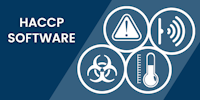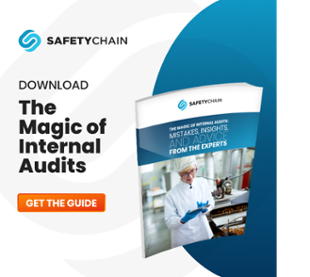A Guide to HACCP Software & How It Works
Food and beverage facilities have an obligation to create safe products for consumers. Not only is this critical for maintaining compliance, but it’s also essential to promoting a strong brand reputation and, most importantly, supporting public health. There are many approaches companies can use to maintain safety throughout every aspect of manufacturing and the supply chain as a whole, one of the most common of which is HACCP. Discover what this systematic approach entails here, along with the ways in which technology can streamline your HACCP program.
What Is HACCP?
Hazard Analysis Critical Control Point (HACCP) is defined by the FDA as “a management system in which food safety is addressed through the analysis and control of biological, chemical, and physical hazards from raw material production, procurement and handling, to manufacturing, distribution, and consumption of the finished product.” Simply put, HACCP is a system Food & Beverage companies use to manage food safety.
The FDA requires juice and meat to implement HACCP programs. In the meat industry, HACCP requirements are overseen and enforced by the USDA, whereas seafood and juice are FDA-regulated.
Why Is HACCP Important?
HACCP is internationally recognized, so the standards for the management system are comparable for Food & Beverage companies all across the world. Thus, being HACCP-certified can improve business prospects for companies seeking to secure additional customers. It also helps Food & Beverage companies meet regulatory requirements and improve product quality and safety. In some cases, becoming HACCP-certified can also help companies become more efficient, reduce costs, and decrease time to market.
The overarching objective of a HACCP plan is to control potential hazards, including contaminants that are:
Microbiological
Physical
Chemical
In proactively addressing these risks, companies can promote public safety more effectively. The HACCP Alliance explains that microbiological hazards are among the most significant hazards facing the food industry, including:
E. coli
Listeria
Salmonella
Campylobacter
Clostridium botulinum
The Seven Principles of HACCP
A HACCP plan must follow seven key steps as outlined by the FDA:
1. Conduct a Hazard Analysis
First, Food & Beverage companies must outline the detailed steps involved in their processes and identify the areas where significant hazards are likely to occur. Once you have an outline of each process, you can then identify which hazards can be prevented, eliminated, or controlled through an effective HACCP plan. If rationale for including or excluding specific hazards from your HACCP program should be detailed within the plan as well.
2. Determine Critical Control Points (CCPs)
Critical control points (CCPs) are points, steps, or procedures where measures are implemented to control a specific food safety hazard. For instance, CCPs could include:
Cooking/cooling to a specific temperature
Packaging
Metal detection
3. Establish Critical Limits
Critical limits (CLs) are the minimum and/or maximum values to which chemical, biological, or physical measures must be controlled to eliminate or reduce a hazard. CLs are typically metrics such as time, temperature, or weight. They might also encompass other parameters outlined by regulatory standards.
4. Establish Monitoring Procedures
HACCP plans must include monitoring procedures to measure CLs at the required CCPs. The plan must also list details about how the measurement will be taken, including who will record the data and when.
Examples of monitoring of CCPs could be:
Observational monitoring, such as keeping up with cleaning schedules
Sensory monitoring, including the use of sight and smell to verify products are up to standards
Chemical monitoring, including nutritional analyses
Physical monitoring, such as checking temperature and weight
5. Establish Corrective Actions
When a deviation in a CL develops, you must use a corrective action to correct it and prevent it from happening again in the future. Corrective actions should pinpoint the problem and its cause, along with the remedial steps that will be taken to prevent it from recurring.
Immediate corrective actions stop problems that are currently happening, whereas preventive corrective actions are meant to control risks that could happen in the future. An immediate corrective action might be discarding food that has been contaminated, while a preventive one could be having a piece of equipment repaired.
6. Establish Verification Procedures
To ensure the HACCP plan is valid and working effectively, you will need to establish verification activities. Examples could include auditing CCPs, records review, testing finished products, and calibrating instruments as needed.
7. Establish Record-Keeping & Documentation Procedures
Recordkeeping is an integral component of a HACCP plan. Records must include all the information about the plan for employees to reference, but they must also act as proof that food is being produced safely and in a way that complies with current regulations. Your facility’s HACCP records should include a hazard analysis, CCPs, CLs, monitoring system, corrective actions, recordkeeping procedures, and verification activities.
A unique HACCP plan is required for every food and processing system, since they each have specific risks which must be addressed individually.
HACCP Certification
Customers across the globe are increasingly looking to partner with HACCP-certified companies. HACCP certification is a rigorous review that ensures your facility’s HACCP program satisfies all current compliance standards.
HACCP certification requires you to successfully pass an audit performed by an approved third party. During the certification process, the auditor will assess your program and documentation to ensure they comply with the seven principles outlined above. Typically, certification lasts for three years, after which you’ll need to reapply for certification and undergo an audit once again. You may also need to go through surveillance audits periodically.
Most audits are conducted in two phases. First, the auditor will assess your systems to verify that your HACCP program fulfils the seven requirements. Next, they’ll perform an in-depth evaluation of your records. During the closing meeting, your auditor will give a verbal report of their findings, including any nonconformities. They’ll then give their recommendation for certification and any action items that need to be addressed.
HACCP Training
Leaders in Food & Beverage companies might take a HACCP training course to gain deeper knowledge of the program’s principles and requirements. This is an especially worthwhile investment if you’re new to HACCP. You can expect typical training courses to outline topics such as:
Good manufacturing practices (GMPs)
How to identify and analyze hazards
Control measures and critical control points
Critical limits
Monitoring systems
Documentation practices
Employee training
Consider looking for training that applies to your industry specifically to get the most from your course.
How Does HACCP Software Help Food & Beverage Companies?
As you might imagine, managing such a significant volume of records for HACCP—in addition to other programs—can become overwhelming for facilities. For this reason, many organizations leverage automated HACCP software to organize and manage compliance requirements in one convenient system.
Oftentimes, the challenge of effectively managing HACCP lies in the analysis portion of the system, because there is limited visibility into everyday operations. HACCP software solves this challenge.
HACCP software is designed to proactively reduce food safety risks and ensure ongoing compliance with a broad range of food safety and quality management programs. This technology not only can help you manage food safety protocols like HACCP more effectively, but it can also facilitate better supplier, regulatory, and GFSI compliance.
Software provides ongoing, real-time insights into your program activities, allowing you to better manage your food safety protocols. Data is collected through three means: mobile forms, automated equipment data extraction, and online portals. All of your records then become stored and easily accessible in one centralized system. With dashboards and reporting, you can monitor progress across multiple facilities, ensuring completion of tasks such as corrective and preventive action (CAPAs). Plus, you can check on updates or submission of forms and review documentation to make certain that everything is on track at all times.
In addition to ensuring safety protocols are being met regularly, you can also use analytics to track performance over time. Trending and analysis tools give you the power to pinpoint any Key Performance Indicators (KPIs) needing improvement, as well as areas in which your facility consistently excels. With access to business intelligence, your management teams will have the information they need to drive continuous improvement and manage HACCP more effectively.
About SafetyChain Software
SafetyChain is a Digital Plant Management Software that helps food and beverage companies improve productivity, profitability, and compliance with a flexible, user-friendly software platform that captures, manages, and analyzes real-time operations data.




